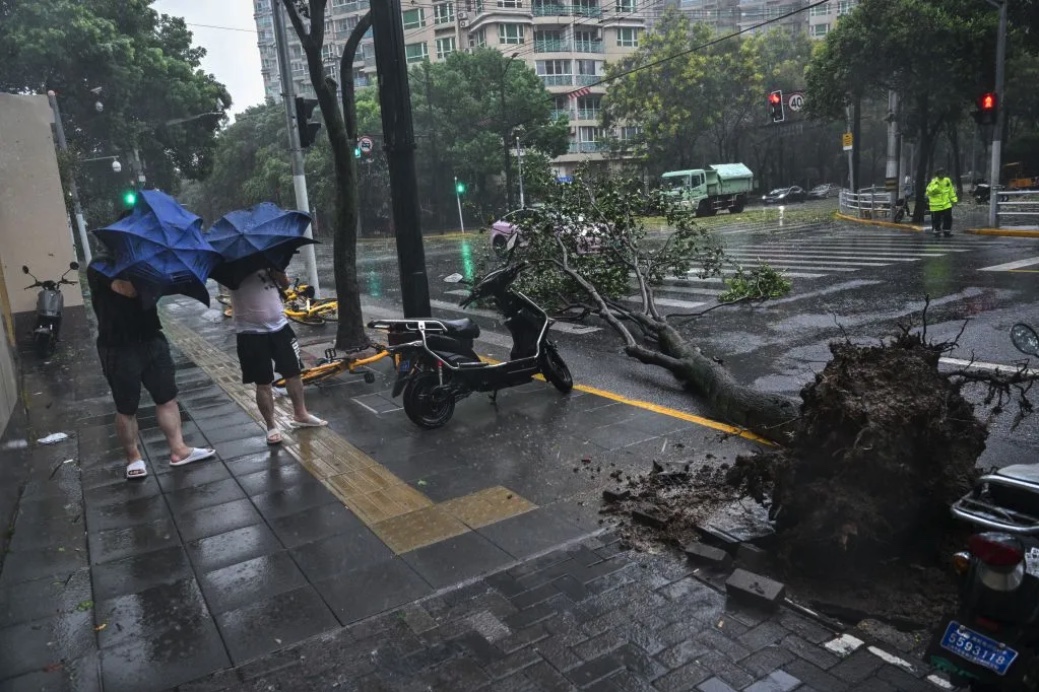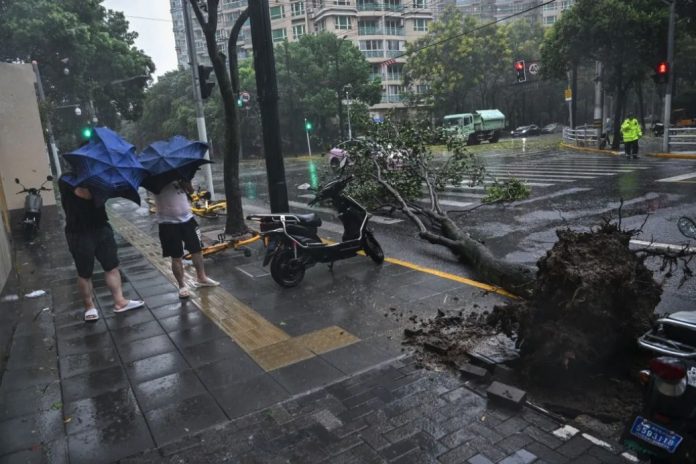มีการอพยพผู้คนหลายแสนคนเนื่องจากพายุไต้ฝุ่นรุนแรงพัดขึ้นฝั่งใกล้กับศูนย์กลางการเงินของจีน คือเมืองเซี่ยงไฮ้
ไต้ฝุ่นเบบินกา (Bebinca) พัดขึ้นฝั่งประมาณเวลา 07:30 น. ตามเวลาท้องถิ่น (23:30 น. GMT) ในวันจันทร์ในพื้นที่ชายฝั่งของเมืองใหม่หลินกาง (Lingang New City) ทางตะวันออกของเซี่ยงไฮ้ ตามรายงานจากสำนักงานอุตุนิยมวิทยาจีน
พายุลูกนี้ถือเป็นพายุที่รุนแรงที่สุดที่พัดถล่มเซี่ยงไฮ้ในรอบ 75 ปี ตามรายงานของสื่อมวลชนจีน
เพื่อเป็นการป้องกันไว้ก่อน เจ้าหน้าที่ท้องถิ่นระบุว่ามีการย้ายผู้คนกว่า 400,000 คนออกจากพื้นที่ในเขตมหานครเซี่ยงไฮ้ ภายในเย็นวันอาทิตย์
นอกจากนี้ยังมีการอพยพอีก 9,000 คนออกจากเขต Chongming ซึ่งเป็นเกาะที่ปากแม่น้ำแยงซี (Yangtze) ซึ่งเป็นส่วนหนึ่งของเซี่ยงไฮ้เช่นกัน
เที่ยวบินหลายร้อยเที่ยวถูกยกเลิกเมื่อสนามบินหลักทั้งสองแห่งของเมืองหยุดให้บริการการบินทั้งหมด บริการรถไฟก็ถูกยกเลิกและทางหลวงถูกปิด มีการจำกัดความเร็วบนถนนในเมืองที่ 40 กม./ชม. (25 ไมล์/ชม.)
เจ้าหน้าที่แนะนำให้ประชากร 25 ล้านคนในเซี่ยงไฮ้พักอยู่ที่บ้าน เนื่องจากพายุได้พัดถล่มเมืองอย่างหนัก
ทางการได้ประกาศเตือนภัยระดับสีแดงสำหรับพายุเบบินกา ซึ่งเป็นระดับสูงสุด โดยมีการบันทึกความเร็วลมสูงสุดถึง 151 กม./ชม. (94 ไมล์/ชม.) ที่จุดตาพายุ คาดว่าพายุจะอ่อนกำลังลงเมื่อเคลื่อนตัวเข้าสู่แผ่นดิน
วิดีโอที่โพสต์ทางออนไลน์แสดงให้เห็นต้นไม้ใหญ่ถูกพายุพัดล้มลง และผู้คนกำลังลากจักรยานและมอเตอร์ไซค์ของพวกเขาผ่านถนนที่น้ำท่วมหนัก คลิปหนึ่งที่ถูกแชร์โดย Shanghai Daily แสดงให้เห็นรถบัสเบรกกระทันหันบนถนน Huaihai ในย่านช็อปปิ้งหลัก เนื่องจากป้ายโฆษณาที่ถูกลมพัดแรงตกลงมาบนพื้น
พายุลูกนี้กลายเป็นหนึ่งในหัวข้อที่มีคนพูดถึงมากที่สุดในโซเชียลมีเดียจีน Weibo เมื่อวันจันทร์ โดยผู้ใช้บางคนแสดงความกังวลว่าพายุจะทวีความรุนแรงขึ้น
“นี่คือสิ่งที่คุณเห็นในทีวีเท่านั้น” ผู้ใช้ Weibo คนหนึ่งเขียนพร้อมโพสต์วิดีโอของต้นไม้ที่ถูกลมแรงพัดจนโยกไปมาที่ลานจอดรถ
ผู้ใช้อีกคนเตือนให้คนอื่นตรวจสอบให้แน่ใจว่าประตูและหน้าต่างของพวกเขาถูกล็อกอย่างแน่นหนา และไม่ออกจากบ้านหากไม่จำเป็น
เป็นเรื่องไม่ปกติที่เซี่ยงไฮ้จะถูกพายุไต้ฝุ่นรุนแรงพัดถล่มโดยตรง โดยปกติพายุมักจะขึ้นฝั่งในพื้นที่ทางตอนใต้ของจีนมากกว่า
ศูนย์บัญชาการควบคุมอุทกภัยของเมืองระบุว่าพวกเขาได้รับรายงานเหตุการณ์ที่เกี่ยวข้องกับพายุไต้ฝุ่นหลายสิบเหตุการณ์ ซึ่งส่วนใหญ่เป็นต้นไม้ล้มและป้ายโฆษณาที่ถูกพายุพัด
รีสอร์ทในเซี่ยงไฮ้หลายแห่ง รวมถึง Shanghai Disney Resort สวนสนุก Jinjiang และสวนสัตว์ Shanghai Wild Animal Park ถูกปิดชั่วคราว และเรือข้ามฟากหลายลำก็หยุดให้บริการ
ก่อนหน้านี้ ไต้ฝุ่นยากิ (Yagi) คร่าชีวิตผู้คนอย่างน้อย 4 คน และทำให้มีผู้บาดเจ็บ 95 คน เมื่อมันพัดผ่านเกาะไห่หนานทางตอนใต้ของจีนในเดือนนี้ ตามรายงานของทางการอุตุนิยมวิทยาแห่งชาติ
ยากิยังทำให้เกิดน้ำท่วมรุนแรงในเอเชียตะวันออกเฉียงใต้ โดยมีผู้เสียชีวิตหลายร้อยคนในเวียดนามและเมียนมา
พายุไต้ฝุ่นเบบินกายังพัดผ่านญี่ปุ่นและฟิลิปปินส์ตอนกลางและตอนใต้ ซึ่งมีต้นไม้ล้มคร่าชีวิตผู้คน 6 คน
สื่อของรัฐจีนรายงานว่า เบบินกาคาดว่าจะเคลื่อนตัวไปทางตะวันตกเฉียงเหนือ ทำให้เกิดฝนตกหนักและลมแรงในมณฑลเจียงซู เจ้อเจียง และอันฮุย
Shanghai hit by strongest typhoon in 75 years

Hundreds of thousands of people were evacuated as a powerful typhoon made landfall near China’s financial hub, Shanghai.
Typhoon Bebinca hit at about 07:30 local time (23:30 GMT) on Monday in the coastal area of Lingang New City in Shanghai’s east, the China Meteorological Administration said.
It is the strongest storm to hit Shanghai in 75 years, according to Chinese state media.
As a precaution, more than 400,000 people in the Shanghai Metropolitan area were relocated by Sunday evening, according to local officials.
A further 9,000 people were evacuated from the Chongming District, an island at the mouth of the Yangtze River that is also part of Shanghai.
Hundreds of flights were cancelled as the city’s two main airports grounded all flights. Train services were also cancelled and highways closed. A 40km/h (25mph) speed limit was imposed on roads inside the city.
Shanghai’s 25 million residents had been advised to stay home as the storm batters the city.
Authorities have issued a red alert for Bebinca, the highest level, as wind speeds of up to 151km/h (94 mph) were recorded at the typhoon’s eye. It is expected to weaken as it moves inland.
Videos posted online showed large trees toppled and people dragging their bicycles and motorcycles through flooded streets. A clip shared by Shanghai Daily showed a bus braking abruptly along Huaihai Road in a major shopping district as billboards blown by fierce winds collapsed onto the ground.
The storm was one of the most-discussed topics on Chinese social media platform Weibo on Monday, with some users sharing their fears that it would worsen.
“This is the kind of thing you’d only see on television,” wrote one Weibo user, who posted a video of trees swaying violently in a car park.
Another user advised others to make sure their doors and windows are properly locked and not to leave their homes unnecessarily.
It is rare for Shanghai to get a direct hit from strong typhoons, which tend to make landfall further south in China.
The city’s flood control headquarters said they received dozens of reports of incidents related to the typhoon – mostly fallen trees and billboards.
Resorts in Shanghai, including Shanghai Disney Resort, Jinjiang Amusement Park and Shanghai Wild Animal Park, have been temporarily closed and many ferries halted.
Another typhoon, Yagi, killed at least four people and injured 95 when it passed through China’s southern Hainan island this month, according to national weather authorities.
Yagi also caused severe flooding in Southeast Asia, killing hundreds of people in Vietnam and Myanmar.
Typhoon Bebinca also passed through Japan and the central and southern Philippines, where falling trees killed six people.
Chinese state media said Bebinca was expected to move north-west, causing heavy rain and high winds in Jiangsu, Zhejiang and Anhui provinces.
By Nick Marsh and Kelly Ng, BBC News

















